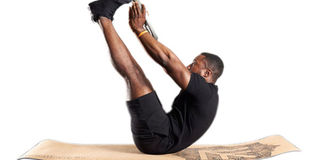How much exercise do you really need?

What you need to know:
Exercise can have immediate and long-term health benefits. However, what is the benchmark if you are trying to squeeze enough healthy exercise into your life?
Regular exercise and weight loss feature highly on a large percentage of the adult population’s New Year resolutions. In our zeal to get to our optimum level of fitness or body weight, we tend to want to do too much hoping it will produce the results we are looking for.
According to Abrahuman Sulaiman aka Coach Nash the amount of exercise depends on the individual’s goals.
“But the truth is, you do not need to spend days at the gym in order to get results. The fact is very few people have that amount of time and that is why gym time is the first thing to go when one gets busy. Fortunately you can get what you are looking for by doing less than you think because effective exercising is not about the quantity but the quality,” he notes.
Coach Nash observes that when people first join the gym, they feel happy to spend about 45-minutes walking on a treadmill or doing aerobics. These forms of Low Intensity Steady State training do help your body to burn fat, but it takes longer probably weeks to get the see results you were hoping for.
“And this is when people start to lose interest because they do not see the results for their efforts,” he observes.
Time
To avoid the disappointment, fitness trainer Kenneth Wariago recommends incorporating high quality exercises that can be done in the shortest amount of time possible. “Get a workout that combines exercises for body weight, muscle and strength building.
The right combination works your whole body as it incorporates several large muscle groups at any one time. It is challenging, effective at making your body work hard and burn fat and can be done in less than 30 minutes,” Wariago reveals.
This form of training is known as High Intensity Interval Training, and can be done in 10-15 minutes. It consists of two workout periods, called the work and rest periods. “This high-energy cardio and sculpting routine helps to boost your metabolism, melt fat, and burn calories.
By performing total-body strength moves along with high-intensity interval workouts, you will be able to reshape your body in a relatively short period of time,” he says adding that shorter, high-intensity interval-based routines can be more effective than longer, slow-paced ones.
This is because you are moving at a high intensity, you will not only burn more calories during the workout, but it will also increase your metabolism for several hours afterward.
Long and short workouts
Wariago recommends incorporating a mixture of long and short workouts into your schedule, where possible.
“Do the long, low-intensity workouts when you have time such as on weekends but when you are pressed for time, focus on shorter, high-intensity ones. This way you will see results sooner than later while not having to spend a lot of time at the gym,” Wariago recommends.
Wariago observes that people tend to mistake physical activity and exercise.
“For physical activity such as climbing stairs, doing house chores or and walking, the more the one does the better. While for exercise the quality and intensity are better than long duration,” he explains.
Coach Nash emphasizes that any bit of activity helps. While fitness may improve with only a twice weekly workout, aim for three or five 20 minutes of higher intensity activity per work.
Example of a workout plan
Monday: 30 min High-Intensity Interval Training(HIIT). Alternate one minute running (10 mph) with two minutes of walking (4.5 mph) for 30 min, calories 320. Basic Total Body, 30 min, 100 calories.
Tuesday: 60 min kickboxing class, 550 calories.
Wednesday: 30-45 min Lower Body Strength, 300 calories, 15-minute stretching, 42 calories.
Thursday: 60 min yoga class, 170 calories.
Friday: 45 min HIIT - Alternate one minute 10 mph with two minutes at 4.5 mph for 45 minutes.
Saturday: 30 min Upper Body Workout 150 calories.
Source: fitnessgenes.com




